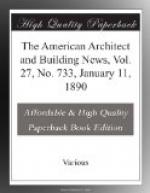* * * * *
BOOKS IN WATER-COLOR PAINTING.
SPOKANE FALLS, WASH., December 11, 1889.
TO THE EDITORS OF THE AMERICAN ARCHITECT:
Dear Sirs,—Will you kindly advise, through the columns of your paper, what is the best self-instructing work on architectural water-coloring, and oblige.
INQUIRER.
[The best drill for the eye and hand that we know of can be obtained in the shortest time by getting Buskin’s “Elements of Drawing,” and doing faithfully and exactly all the exercises which he prescribes, including both those in black-and-white and color. Many people, however, do not care for this drill, but prefer to make a few bad imitations of simple chromos, and consider that equipment enough for architectural work. For those, Penley’s large work, the “System of Water-Color Painting” is the best for copying from; or the aspirant may get some of the little Winsor and Newton “Handbooks on Sketching in Water-Colors,” to show him how to choose and mix his pigments, and use as models to copy from some of the colored prints of architectural subjects which are to be picked up in the stores. There is a good deal of choice among these. We have ourselves published one or two, from originals by Mr. Botch, which will answer as well as anything we know, being admirable in color and architectural feeling, and just sketchy enough. Pains should generally be taken not to make an elaborate picture of an architectural sketch, and the processes preliminary to making a highly-finished water-color painting, such as laying a ground-color of neutral orange, and sponging it partly out, cutting out foreground lights with a knife, and so on, are best dispensed with. Chinese white, also, should be used very sparingly, and only where the scale is so small that it appears in the form of dots. A good lesson on the importance of keeping color subdued, for the sake of heightening architectural effect, can be derived from any of Front’s works, which, by the way, might with great advantage be used to copy from. These will show the value of what most students consider beneath their notice—work in two tints and give the best models possible of artistic distribution of light and shade.—EDS. AMERICAN ARCHITECT.]
* * * * *
[Illustration: NOTES AND CLIPPINGS]
THE DUTY ON GLASS AS IT AFFECTS CONSUMERS.—In a letter to the New York Times, Mr. J.S. Moore writes: As I am on the subject of glass, and as the members of the Pan-American Congress are inspecting our magnificent metropolis, I wish to call their attention to two subjects. First, our dirty streets, and second, our splendid windows. Dickens has immortalized the “Golden Dustman.” In this city we have the “Dirty Ringman,” or we may say “Ringmen.” There have been millions in New York’s dirty streets.




